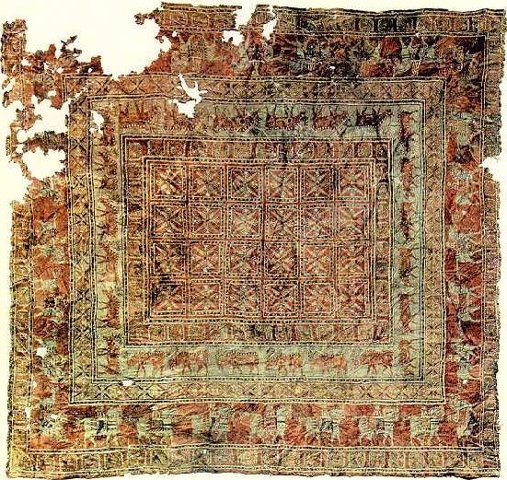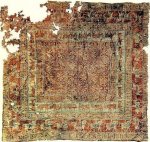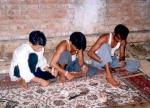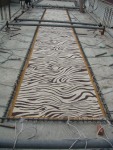Today’s hand knotting technique is centuries old!!!
In a unique archaeological excavation in 1949, the exceptional Pazyryk carpet was discovered among the ice of Pazyryk Valley, in Altai Mountains in Siberia. The carpet was found in the grave of a Scythian prince. Radiocarbon testing indicated that the Pazyryk carpet was woven in the 5th century BC. This carpet is 283 by 200 cm (approximately 9.3 by 6.5 ft) and has 36 symmetrical knots per cm² (232 per inch²).The advanced weaving technique used in the Pazyryk carpet indicates a long history of evolution and experience in this art. Pazyryk carpet is considered as the oldest carpet in the world. Its central field is a deep red color and it has two wide borders, one depicting deer and the other Persian horseman.
Over the centuries the technique used to make this masterpiece has little changed. As seen below today’s process is still much the same with nearly every step still performed by hand. Today there is a thriving market for antique rugs, with many devoted collectors and enthusiasts, all of these rugs are hand-knotted in construction as today’s hand-tufted and power-loomed rugs are unable to stand up to the time and use these rugs under-go. With quality workmanship, good materials and proper care these rugs can stand up in high traffic areas for well over 100 years. As such many hand-knotted rugs are considered heirlooms and are often passed down through families. It is not uncommon for the rug to take longer to make then the house that it makes a home in took to build.
- Oldest known hand-knotted rug, the Pazyryk carpet.
- Before a rug can be woven a template of the design must be created for each available size. Much like every step of the process with hand knotted rugs this is done by hand. This template, called a nakshaw, is hand drawn hand copied and hand colored for each size. This is done in a way that it shows the weaver exactly which knot to tie as well as where and when it must be tied.
- Here a nakshaw is shown on the loom with the warp threads already strung and the weaving is now ready to begin. Prior to weaving, thousands of warp threads must be painstakingly placed one at a time across the width of the loom, a process that can take many hours in itself. These warp threads will make up the foundation of the rug with the knots being ties around it, it will also become the fringe once complete.
- Once a nakshaw has been made in the correct size and the loom has been prepped with the warp threads being strung the weaving is ready to begin. This is the most time consuming step in the process, a 9×12 rug would take a single weaver around 1,500 hours to complete! Large rugs however are made with multiple weavers significantly shortening the production time. It is not uncommon for a 9×12 rug to have upwards of 2 million knots, all tied individually by hand!
- Far from being complete the rug continues its journey with incredible attention to detail. As a rug is taken off the loom and the tension released, the whole of the rug takes on a little slack. Now it must be tightened; the only way of doing this is with a rod and hammer, slowly pounding down each knot tightly to the weft thread (the thread run across the width of the rug after each row of knots) below. After each knot has been pounded down each weft above must be pounded down as well to carefully reset each knot. From this stage the rug is often washed again to clean any fibers left behind.
- To give a rug greater drama and detailing the pattern is often hand carved around the outline to help highlight the pattern and make it stand out. This is also done by hand with scissors and helps make a rug feel more dramatic by drawing greater attention to the pattern.
- To give a rug greater drama and detailing the pattern is often hand carved around the outline to help highlight the pattern and make it stand out. This is also done by hand with scissors and helps make a rug feel more dramatic by drawing greater attention to the pattern.
- The washing process happens multiple times during a rugs production, water is poured directly onto the rug. Using large wooden paddles similar to a snow shovel the rug is pounded and pressed forcing out the water. Aside from the obvious result of cleaning the rug of dirt and debris this process de-tangles any yarn that has been matted down or missed prior; it also allows for special finishing touches such as tea-washing for an antique effect. One advantage to a hand knotted rug is the ability to really wash it and saturate it for a deep clean. Hand-tufted and power-loomed rugs are unable to be washed in this manner as over-saturation will affect the structural integrity of the rug and cause it fall apart.
- Once washed and ready for drying steps must be taken to prevent the rug from becoming misshapen. As different materials will dry and shrink at different rates a frame is built that allows the rug to be hooked, and tension added to ensure that the shape and size of the rug remain as intended.
- Finally woven, washed, trimmed, cleaned and detailed the rug is ready to begin its finish. After the process leading up to this point the rug still has bare ends showing on all sides. The warp and weft threads which the knots are tied around and secured with must be dealt with. The sides of the rug are bound with what’s called a selvedge which hides the weft along the sides of the rug. Typically the ends are then tied to make the fringe; sometimes however they are tucked and sewn, similar to the selvedges.
- From the design conception, to the nakshaw, then off to the loom for weaving, down for trimming, out for washing, in for more trimming, out for more washing and all the finishing touches complete thousands of hours have passed. The rug is now rolled, identified, wrapped and ready for export. It is not uncommon for the rug to take longer to make then the house that it makes a home in took to build.
- With the exception of the loom and some wooden paddles for washing these simple tools are essentially all that is needed for making such a beautiful masterpiece.












